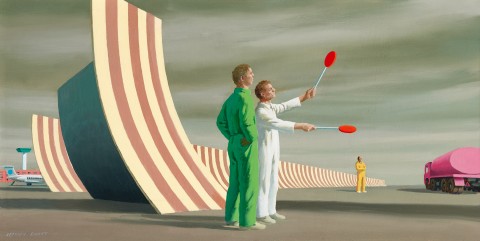MADRAS AIRPORT, 1979
JEFFREY SMART
oil on board
34.5 x 66.5 cm
signed lower left: JEFFREY SMART
Rudy Komon Art Gallery, Sydney
Private collection
Sotheby’s, Melbourne, 24 July 1988, lot 351 (as ‘Airport’)
Private collection, Melbourne
Jeffrey Smart, Rudy Komon Art Gallery, Sydney, 8 November – 30 December 1980, cat. 36
Quartermaine, P., Jeffrey Smart, Gryphon Books, Melbourne, 1983, cat. 753, pp. 51 (illus.), 116
McDonald, J., Jeffrey Smart / Paintings of the '70s and '80s, Craftsman House, Sydney, 1990, cat. 197, p. 159
First Study for Madras Airport, 1979, oil on canvas, 27.0 x 38.0 cm
Second Study for Madras Airport, 1979, oil on canvas, 29.5 x 39.5 cm
Third Study for Madras Airport, 1979, oil on canvas, 33.0 x 65.0 cm
Figure Studies for Madras Airport, 1979, oil on canvas, 28.0 x 35.5 cm
We are grateful to Stephen Rogers, Archivist for the Estate of Jeffrey Smart, for assistance with this catalogue entry.
‘… Most artists today don’t paint the cars we travel in, factories people work in, roads, road-signs, and airports we all use. I like living in the 20th century – to me, the world has never been more beautiful. I am trying to paint the real world I live in, as beautifully as I can, with my own eye.’1
Although deriving his subject matter from all that would appear disturbing about the modern world – bleak highways, industrial landscapes inhabited by motorised traffic, and an impersonal contemporary architecture that seems unforgiving to human presence – Smart’s paintings are quite assuredly not commentaries upon urban alienation or the human condition. To The contrary, Smart rejoices in the beauty and oddity he perceives within the contemporary urban environment, translating momentary glimpses of the everyday into impeccably composed harmonies of colour, shape and line – all imbued with originality, irony and an inescapable feeling of expectancy. Elaborating upon his fascination with airports in particular, Smart observed: ‘Aerodromes are beautiful and exciting places, especially in a side light or on a misty day when they assume a threatening atmosphere.’2 As encapsulated by the superb example on offer, one of the most intriguing aspects of Smart’s airport paintings is the stark contrast between the almost total anonymity of the scenes depicted, and the inordinate specificity of their titles.3 Frequently observed by the artist through a window while seated on board a plane or in the waiting lounge, these works are invariably populated with generic images of workmen in overalls refueling aircraft or involved in arcane systems of signaling (as featured here), control towers, airport car parks and observation decks. And yet, titles such as Fumicino Car Park, 1976; Madras Airport, 1979; Night Stop, Bombay, 1981 and The Terrace, Madrid Airport, 1984 – 85 all suggest very precise points of departure.
Like his artistic mentor Cézanne, Smart’s priority has always been the pursuit of the consummate composition – articulated eloquently in his oft-quoted adage, ‘the subject matter is only the hinge that opens the door, the hook upon which one hangs the coat’4 – and certainly, nowhere is this commitment to disegno or draughtsmanship as the basis of his art more poignantly illustrated than in the evolution of Madras Airport. The crystallisation of a specific ‘moment of enchantment’, the final composition here was preceded by at least three oil studies documenting the artist’s experiments with a reversed format; the substitution of different colours for the figures’ overalls; and the inclusion (or otherwise) of elements such as the garish pink oil tanker on the right and the partially-obscured aircraft waiting on the tarmac to the left. A further figure study in oil of potential poses for the three airport workmen reveals, moreover, that Smart’s partner of forty years, Ermes de Zan, served as the model.
That much of Smart’s vast oeuvre fervently celebrates the mechanisms of travel is perhaps not surprising given his lifetime spent as an expatriate. Betraying a sense of place that is at once ambiguous yet strangely familiar, indeed such iconography ‘to some extent reflects his own inveterate travelling as a post-modern figure…’5 As eminent commentator on Smart’s work, Peter Quartermaine elucidates, ‘…For such figures, travel, whether voluntary or enforced, is counterbalanced by an inner sense of loss against which is shored what Salmon Rushdie envisages as ‘imaginary homelands’…’6
1. Smart cited in Jeffrey Smart, Art Gallery of New South Wales, Sydney, 1999, p. 20
2. Smart cited in Capon, E., et al., Jeffrey Smart: Drawings and Studies 1942 – 2001, Australian Galleries, Melbourne, 2001, p. 102
3. Grishin, S., ‘Jeffrey Smart’s Eternal Order of Light and Balance’, in Jeffrey Smart: Paintings and Studies 2002 – 2003, Australian Galleries, Melbourne, 2003, p. 12
4. Smart cited in Capon, E., ‘Still, Silent, Composed: The Art of Jeffrey Smart’, in Jeffrey Smart, 1999, op. cit., p. 14
5. Quartermaine, P., ‘Imaginary Homeland: Jeffrey Smart’s Italy’, in Jeffrey Smart, 1999, ibid., p. 38
6. Ibid.
VERONICA ANGELATOS
